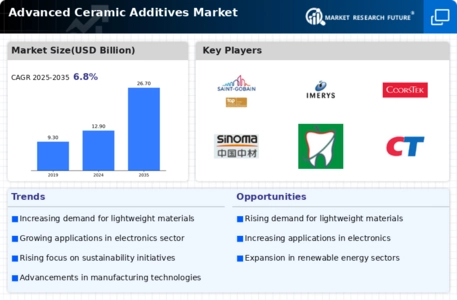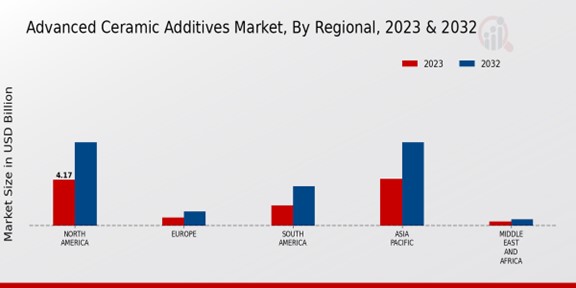Market Growth Projections
The Global Advanced Ceramic Additives Market Industry is projected to experience substantial growth, with forecasts indicating a market size of 12.9 USD Billion in 2024 and an anticipated increase to 26.7 USD Billion by 2035. This growth trajectory reflects a compound annual growth rate of 6.82% from 2025 to 2035, highlighting the industry's resilience and adaptability. Factors such as technological advancements, increasing applications across various sectors, and a focus on sustainability contribute to this positive outlook. The market's expansion signifies the growing importance of advanced ceramics in diverse applications, reinforcing their role in modern manufacturing.
Growing Demand in Electronics
The Global Advanced Ceramic Additives Market Industry experiences a notable surge in demand driven by the electronics sector. Advanced ceramics are increasingly utilized in the production of capacitors, insulators, and substrates due to their superior thermal and electrical properties. As the global electronics market expands, projected to reach 12.9 USD Billion in 2024, the need for high-performance ceramic materials becomes more pronounced. This trend indicates a robust growth trajectory, as manufacturers seek to enhance product reliability and efficiency. Consequently, the Global Advanced Ceramic Additives Market Industry is likely to benefit significantly from this escalating demand.
Emerging Markets and Economic Growth
The Global Advanced Ceramic Additives Market Industry is poised for expansion, particularly in emerging markets where economic growth is accelerating. Countries in Asia-Pacific and Latin America are witnessing increased industrialization and urbanization, leading to higher demand for advanced ceramics in construction, automotive, and electronics. This trend is likely to contribute to the overall market growth, as these regions invest in infrastructure and technology. The expanding middle class in these markets further fuels consumption, suggesting a robust future for the Global Advanced Ceramic Additives Market Industry.
Increasing Applications in Healthcare
The Global Advanced Ceramic Additives Market Industry is significantly influenced by the rising applications of advanced ceramics in the healthcare sector. These materials are utilized in medical devices, dental implants, and prosthetics due to their biocompatibility and mechanical strength. As healthcare technology advances, the demand for high-performance ceramic materials is likely to increase, fostering market growth. The integration of advanced ceramics in innovative medical solutions suggests a promising future, with the market projected to reach 26.7 USD Billion by 2035. This trend underscores the importance of advanced ceramics in enhancing patient outcomes.
Environmental Sustainability Initiatives
Sustainability concerns are increasingly shaping the Global Advanced Ceramic Additives Market Industry. Manufacturers are focusing on eco-friendly production processes and materials to reduce environmental impact. Advanced ceramics, known for their durability and recyclability, align well with these sustainability initiatives. As industries strive to meet stringent environmental regulations, the demand for sustainable ceramic additives is expected to rise. This shift not only supports environmental goals but also enhances the market's appeal to environmentally conscious consumers. The emphasis on sustainability could potentially drive significant growth in the Global Advanced Ceramic Additives Market Industry.
Advancements in Manufacturing Technologies
Innovations in manufacturing technologies play a pivotal role in shaping the Global Advanced Ceramic Additives Market Industry. Techniques such as additive manufacturing and advanced sintering processes enhance the production efficiency and quality of ceramic components. These advancements enable the creation of complex geometries and tailored properties, which are essential for various applications, including aerospace and automotive. As manufacturers adopt these technologies, the market is expected to witness a compound annual growth rate of 6.82% from 2025 to 2035. This growth reflects the industry's adaptability and commitment to meeting evolving customer needs.





















